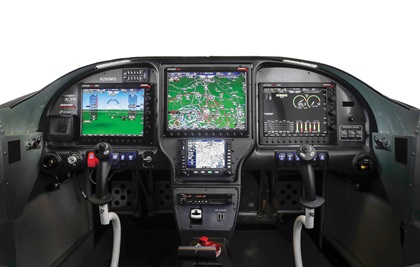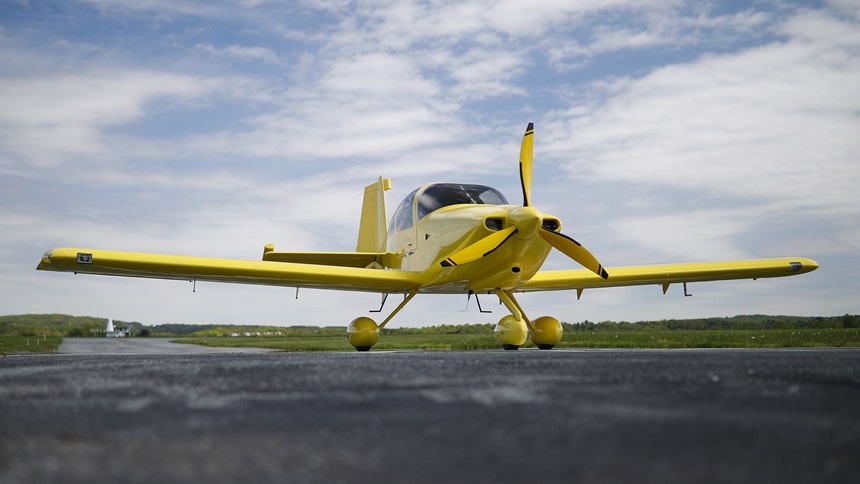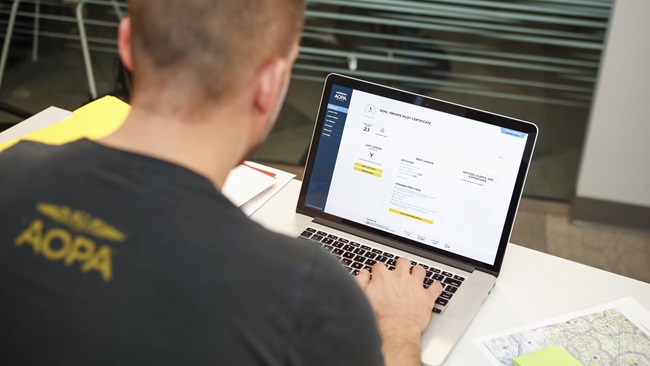Your RV–10 sweeps airplane comes from a cold place
AOPA's 2020 Van's Aircraft RV–10 Sweepstakes underway
The Canadian prairie is a harsh place in winter. Whipping, sub-zero winds roar down from the arctic, and nothing in the flat, featureless terrain even slows them down.
“This airplane was built in 2007 and it’s been flown regularly and well maintained during the time I’ve owned it,” said Rod Benning, a Canadian trucking company operator, who owned the RV–10 for six years before selling it to AOPA in early 2019. “But as you can see from the chips in the paint (where gravel hit the leading edges), the airplane hasn’t been babied. I learned to fly in it, and so did my partner, so it’s done more than its share of takeoffs and landings—and not all of them were things of beauty, if you know what I mean.”
Benning, 55, is stocky and gruff, has a thick beard, drives a Ford 250 pickup, and seems impervious to cold. He wears a short-sleeve Harley-Davidson shirt and no jacket on a 20-degree Fahrenheit day and calls the weather “mild, bordering on a heat wave.”
Benning is quick to laugh, particularly at his own foibles. He seems to know just about everyone in Estevan, his hometown of 10,000 people a few miles north of the North Dakota border; and his accent could have come from the movie Fargo.
Benning breezed through flight training, then used the RV–10 primarily for cross-country trips to visit a daughter in Edmonton, about 600 miles away. But when his daughter and her family moved closer to home, his rationale for owning an airplane disappeared.
“I’ve got to have a purpose to fly, and that purpose went away,” he said. “I know that if I keep the airplane it’ll end up sitting in a hangar, and that’s no good. Better to let it go where it will keep flying.”
Shades of yellow
My first impression of the RV–10 was that it sure is yellow—but not the same yellow. Even under the fluorescent lights in the dim T-hangar, it was obvious the wing tips and fuselage were different shades—the tips, banana; the fuselage, mustard. Black, purple, and gray vinyl accent marks on the fuselage were disregarded since they’re sure to be peeled off early in the restoration process.

The airplane’s metal work appeared excellent, the fiberglass fit and finish was very good, and the Plexiglas was clear and free of crazing. The airframe seemed almost perfectly straight and well rigged, and the fixed trim tab on the rudder was barely deflected.
The 260-horsepower Lycoming IO-540 from Aero Sport Power in British Columbia was installed new when the airplane was built, and it has flown about 620 hours since then. It also had a top overhaul with six new Lycoming cylinders about 250 flight hours ago when some of the exhaust valves showed unusual wear.
The three-blade MT propeller appeared normal, other than the fact that it, too, was painted yellow.
Inside, the bare-bones interior was functional with comfortable, cloth-covered memory foam seats.
The instrument panel was state-of-the-art at the time it was built, with three 7-inch GRT screens and a Garmin 496 portable GPS. But the pace of improvement in avionics is so rapid that the panel seemed quite dated.
Outside the heated hangar, the morning sun had climbed well above the horizon.
“Let’s push it out and fly before the wind comes up,” Benning suggested. “We’ve got a nice day to fly, and that’s kind of rare this time of year.”
I buckled into the four-point harness in the right seat while Benning used a tow bar on the free-castering nosewheel to pull the airplane outside over the crunchy, dry snow.
He opened the gull door on the left side and climbed in to the roomy cockpit. Even with his broad shoulders, the wide cockpit was roomy enough to keep us from bumping.
Engine start was normal, and the oil was 70 degrees Fahrenheit from the heated hangar. We taxied to Runway 26 at the nontowered airfield and “backtracked” as the Canadians say, to use the full length. Despite the airfield elevation of 2,000 feet msl, the cold, dry air lowered the density altitude to a negative number: minus 1,300 feet.

Benning gingerly added full power, and the RV–10 carrying two people and a full 60 gallons of avgas smoothly accelerated to its 65-knot rotation speed. With light back-pressure on the floor-mounted control stick, we were airborne and climbing at 110 KIAS.
The ceiling and visibility were limitless, so the razor-sharp delineation between blue sky and white ground in all directions was remarkable.
Benning handed over the controls and I went through the usual get-acquainted maneuvers: slow flight, stalls, steep turns, and more. The RV–10’s thick wing was incredibly benign with a gentle, power-off stall break and slight left wing drop at just 48 KIAS. Normal cruise at 75 percent power was 172 KTAS at 5,500 feet with fuel consumption of 11.5 gph. Economy cruise at 65 percent power (21 inches MP, 2,300 rpm) was 165 KTAS at 9.2 gph. Normal approach speed at full gross weight was 75 KIAS. The engine/prop combination is exceptionally smooth.
I brought an electrically heated jacket for what I expected to be a cold and drafty cockpit but, perhaps not surprisingly, this Canadian airplane was fitted with an exceptionally effective heater and there was no need for a jacket at all.
After a few takeoffs and landings, there seemed no doubt that this RV–10 was an excellent example of the versatile line of Van’s Aircraft designs that dominates the experimental/amateur-built market with more than 10,000 registered and flying.
That initial impression was confirmed the next day when Benning and I made a short hop to Minot, North Dakota, to clear U.S. Customs. Then we flew 1,350 wind-aided nautical miles to Maryland in two legs that totaled seven flight hours.
Tucked away in a hangar at AOPA’s home base in Frederick, Maryland, Benning patted the RV–10 on the cowl and silently thanked it for helping him become a pilot, and carrying him, his family, and his friends on hundreds of hours of memorable flights throughout their rugged homeland.
“I feel like the airplane just won the lottery,” he said. “It’s a good airplane now. It’ll be a great airplane when you’re done with it.”




